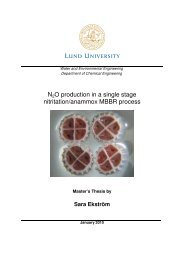Alexander Szabo and Oscar Engle - Svenskt Vatten
Alexander Szabo and Oscar Engle - Svenskt Vatten
Alexander Szabo and Oscar Engle - Svenskt Vatten
Create successful ePaper yourself
Turn your PDF publications into a flip-book with our unique Google optimized e-Paper software.
arrangements which can process sludge. A careful selection of the sludge-treatment method has to<br />
be made, as costs for stabilization, dewatering <strong>and</strong> disposal of sludge may be higher than the<br />
operating cost for the activated-sludge treatment (Hammer, 1986).<br />
In Malaysia facilities for treating sludge are limited <strong>and</strong> today most of the sludge is treated in<br />
sludge lagoons or dried on large sludge-drying beds. Only in semirural areas are these methods<br />
seen as long term solutions. A more long-term solution for urban areas would be to install<br />
digesters <strong>and</strong> mechanical dewatering facilities. Then the gas produced from the digestion<br />
chamber could be captured <strong>and</strong> utilized as fuel.<br />
According to Malaysian st<strong>and</strong>ards presented in Sewerage Services Department (1998) a sludge<br />
strategy consists of three main stages:<br />
Stage 1 – Preliminary treatment <strong>and</strong> digestion<br />
Stage 2 – Conditioning <strong>and</strong> dewatering<br />
Stage 3 – Utilization <strong>and</strong> disposal<br />
In stage 1, the sludge can be thickened in a centrifuge in order to increase the dry-solids content.<br />
After the sludge has been thickened, it is sent to an aerobic or anaerobic digestion chamber.<br />
In stage 2, the stabilized sludge is dewatered in a filter press <strong>and</strong> the dry-solids content in the<br />
sludge is raised to more than 25% (Sewerage Services Department, 1998). Sludge lagoons or<br />
drying beds can also be used in rural areas.<br />
In stage 3, a sludge tank which can h<strong>and</strong>le sludge for more than 30 days must be provided<br />
(Sewerage Services Department, 1998). The final step is composting or disposal of the sludge.<br />
The treated sludge can for example be utilized as fertilizers on fields.<br />
<br />
22















